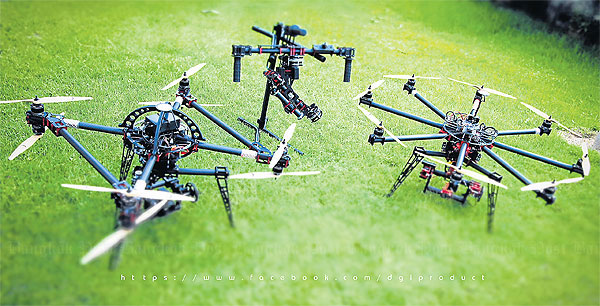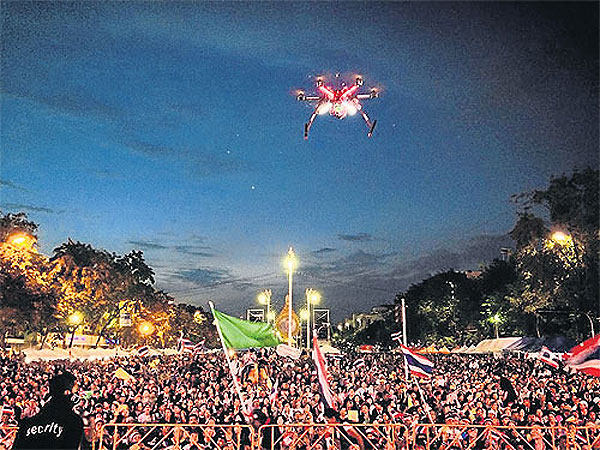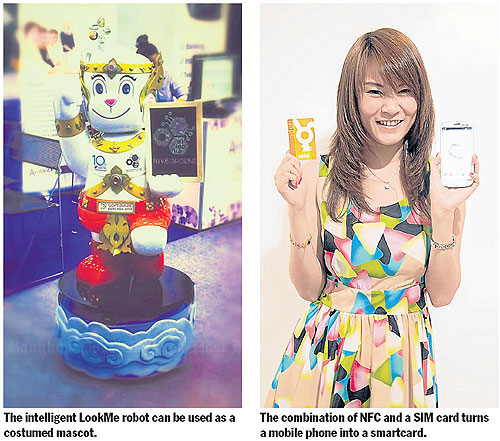
As the popularity of drones for recreational and business use increases, Wachirawat Aungsupanith's unmanned aerial vehicles have taken top prize at the 2013 Samart Innovation Awards
His inventive passion and enduring efforts have finally been rewarded. Wachirawat Aungsupanith, a second-year student at Phetchaburi Rajabhat University, has invented an unmanned aerial vehicle called the "Super Quadrotor", which has won first prize at the Samart Innovation Awards 2013.
This is not Wachirawat's first invention. The Thai talent has been working in the field of unmanned aerial vehicles for a decade. The drone-type invention was originally born when he was a Matayom 2 student and since then he has participated in competitions.
For the Samart Innovation Awards, Wachirawat submitted three types of Super Quadrotor _ one with four rotors, one with six, and one with eight rotors. They can be used for observing atmospheric conditions, conducting field surveys, aerial mapping photography, traffic inspections and reports, and shooting photos.
The vehicle has an electronic control system and sensors for stability. The automatic adjustable system on the tripod equipped in the vehicle enables it to take photos.
"In order to reduce the burden on the vehicle, I ensured the tripod system could do a 360-degree revolution so the camera can view a wide range [while] flying still. The pilot just controls with the remote," said Wachirawat, explaining that there are two sets of controls _ one for the vehicle, the other for the tripod.
Even though he has not yet founded a company, Wachirawat has invented drones that have been used in several fields, including bird's-eye-view reporting, weddings, advertising campaigns and aerial photography.

The Super Quadrotor can be used for photos.
The price for one of his Quadrotors ranges from tens of thousands to hundreds of thousands of baht, depending on the scope of functions and the size of the vehicle.
His unmanned aerial vehicles are in direct competition with imported machines, which are more expensive at prices of about 500,000 baht.
The small Super Quadrotor weighs 2kg and has four rotors containing a small DSLR camera and can fly for some 15-20 minutes, while the larger ones with six and eight rotors are heavier, at about 5kg.
The Samart Innovation Awards is a collaboration between Samart Corporation, the National Science and Technology Agency, and Software Industry Promotion. It is an annual competition that aims to promote youth innovation. Along with training and nurturing, the competition awards 200,000 baht for first prize and 100,000 baht and 50,000 baht for the first runner-up and second runner-up, respectively. The 25 projects that pass the semi-finals are given 20,000 baht each.
At the same competition, two teams were announced as first runners up _ the Smart NFC project by Bluewind Solution and the LookMe robotic platform by HiveGround.
The Smart NFC was created from an idea that combines NFC (Near Field Communication) together with a SIM card, turning a mobile phone into smartcard.
The concept enables cardholders to pay for services with their mobile phone.
A person often holds several cards for different services in their wallet. With the Smart NFC, they need not to carry all the cards because their NFC-embedded mobile phone can function like the smartcard, according to Sruit Angkavanitsuk, president of Bluewind who developed the software programme on the SIM card.
People will be able to use the Smart NFC soon at counter services and convenience stores, True shops, Amazon cafe, and on public transportation such as the BTS and MRT.

Another inventor at the contest has proven that robotics are not just for fun among amateurs or the competition circle, but the technology has been functioning in a wide range of businesses.
The start-up company HiveGround developed the mobile robot mascot platform called LookMe to serve different needs and requirements. The intelligent mobile robot can be used at exhibition fairs as a costumed mascot, and it was first introduced as a robotic Hanuman at Software Expo Asia 2013.
Wannapen Saepian, co-founder of HiveGround, explained that instead of having a man in a costume walking around the fair, the event organiser can have the robot to do the job as it can move and interact with visitors according to a computer programme. Audio playback enables the robot to provide event information to visitors. While the robot is moving around the fair, the event organiser is able to track the location of LookMe through its GPS system embedded in the platform. With a full battery charge, LookMe can work for five hours.
"The robot platform, which is the hardware, has a mechanical system to run based on the software programme, so we can do programming to command the robot according to the requirements of customers," said Wannapen, adding that with the robot mascot creating memorable experiences as well as reinforcing brand recognition, LookMe can serve different businesses such as restaurants, functions, fairs and hospitality events.
The company has been negotiating with a hotel to have LookMe work as a receptionist by customising a robot for loading guest bags. HiveGround is now improving the features of LookMe by enabling the robot to interact with visitors and answer questions.
comments powered by Disqus

